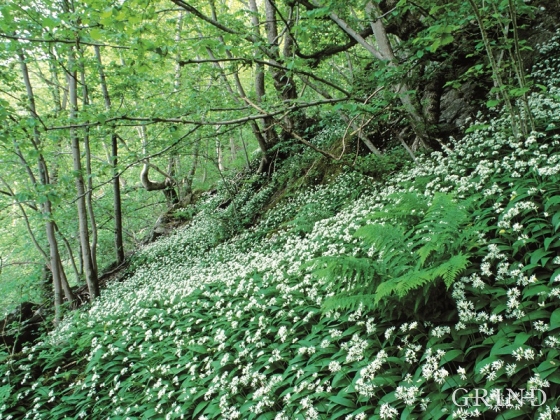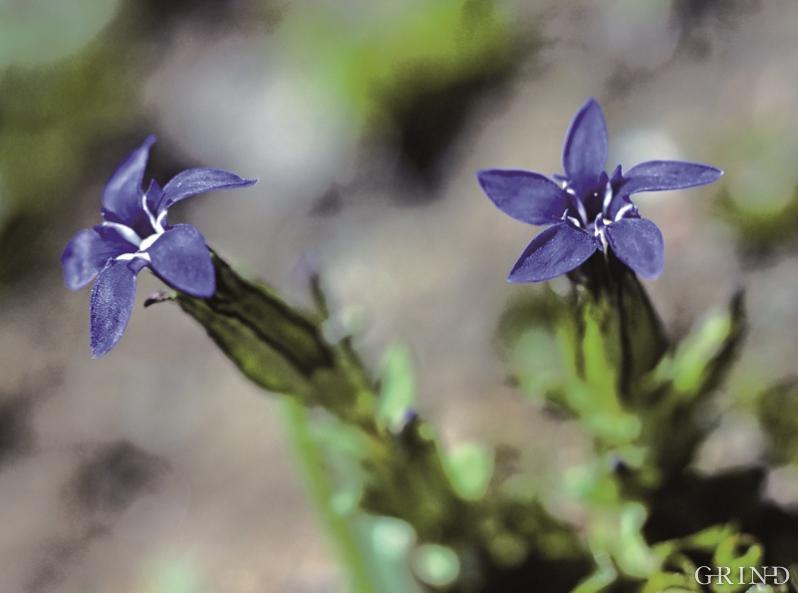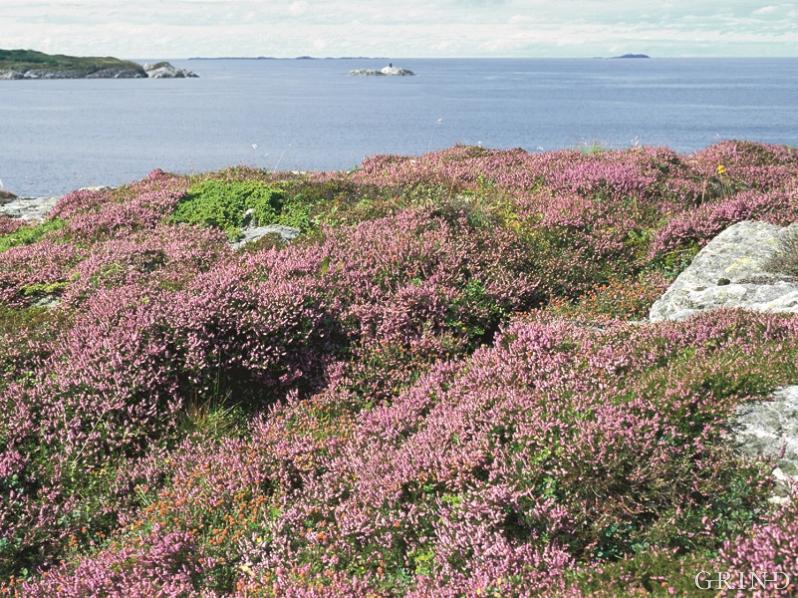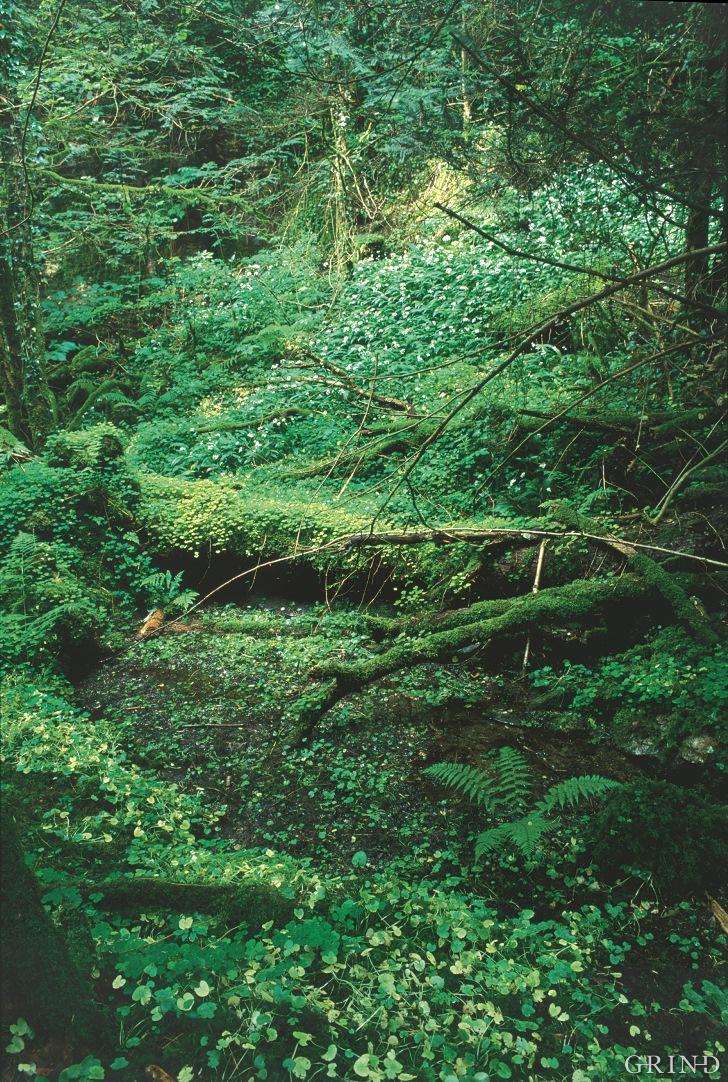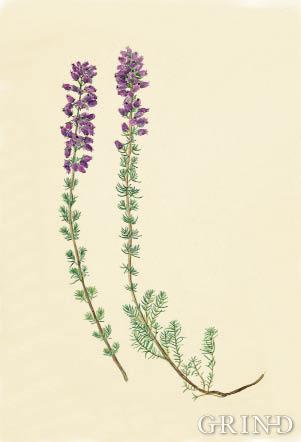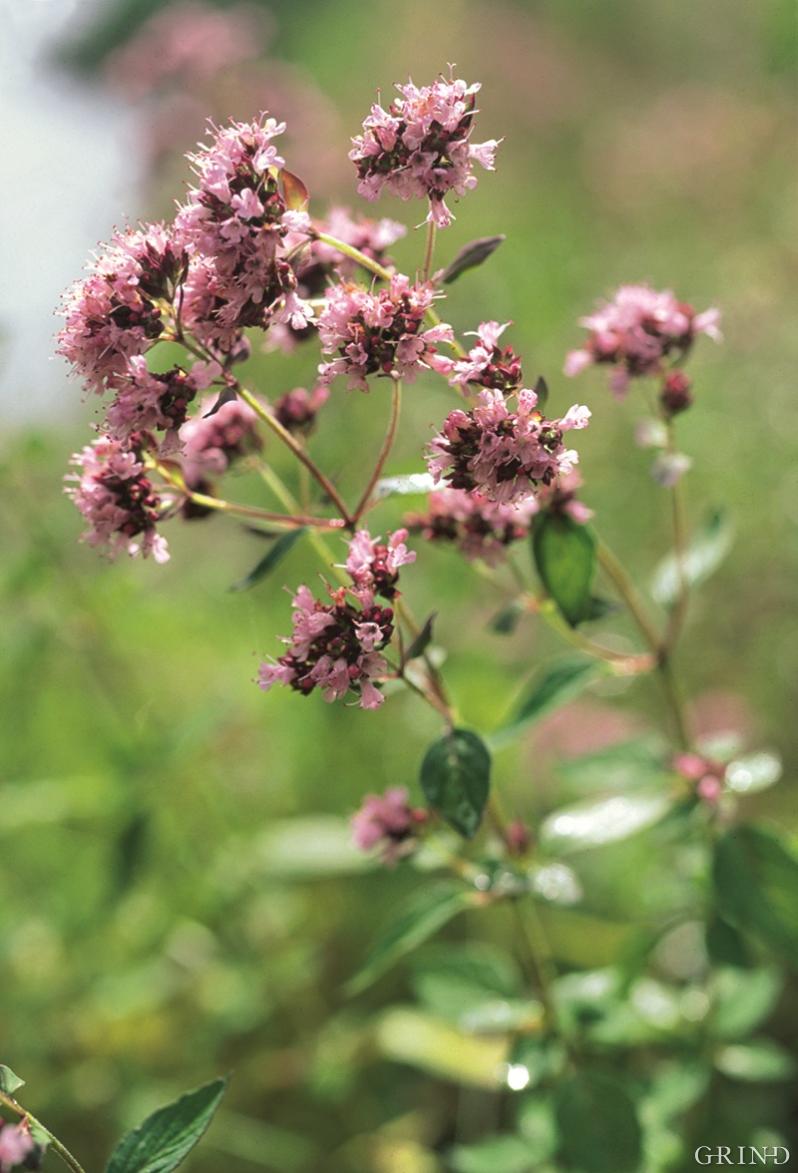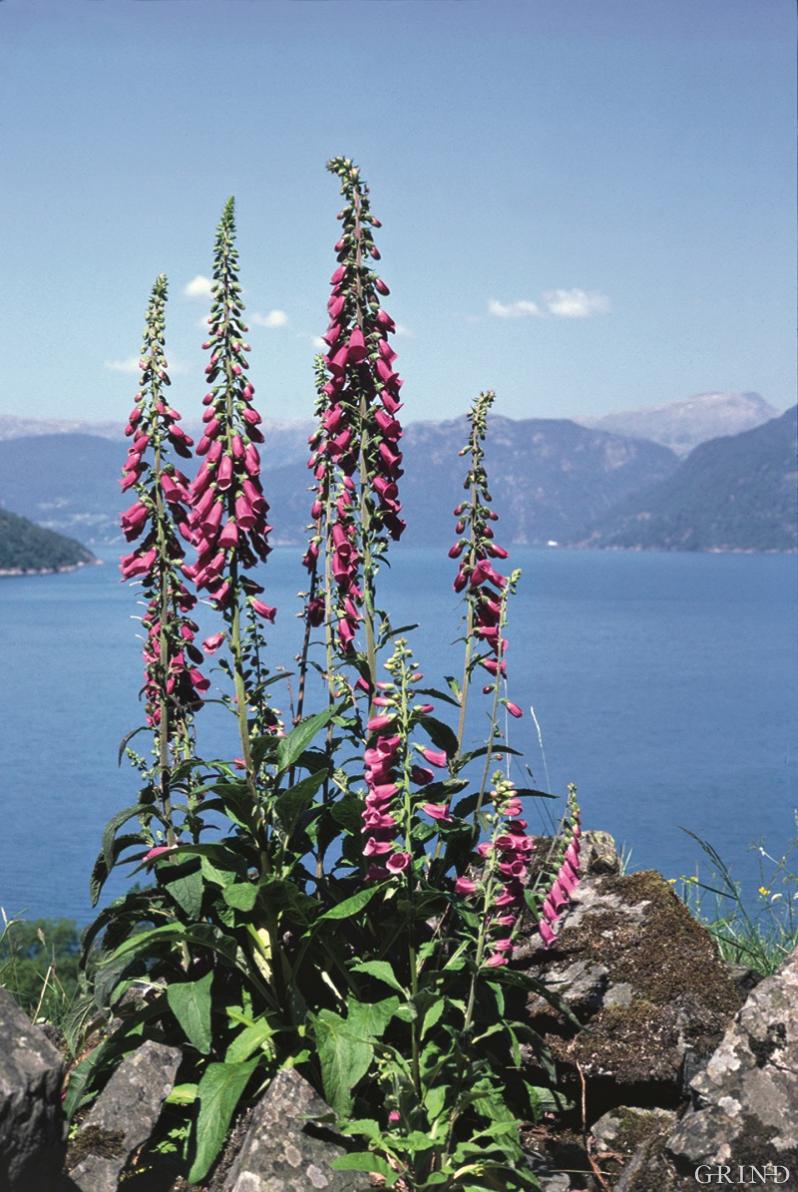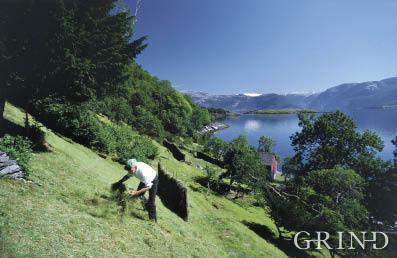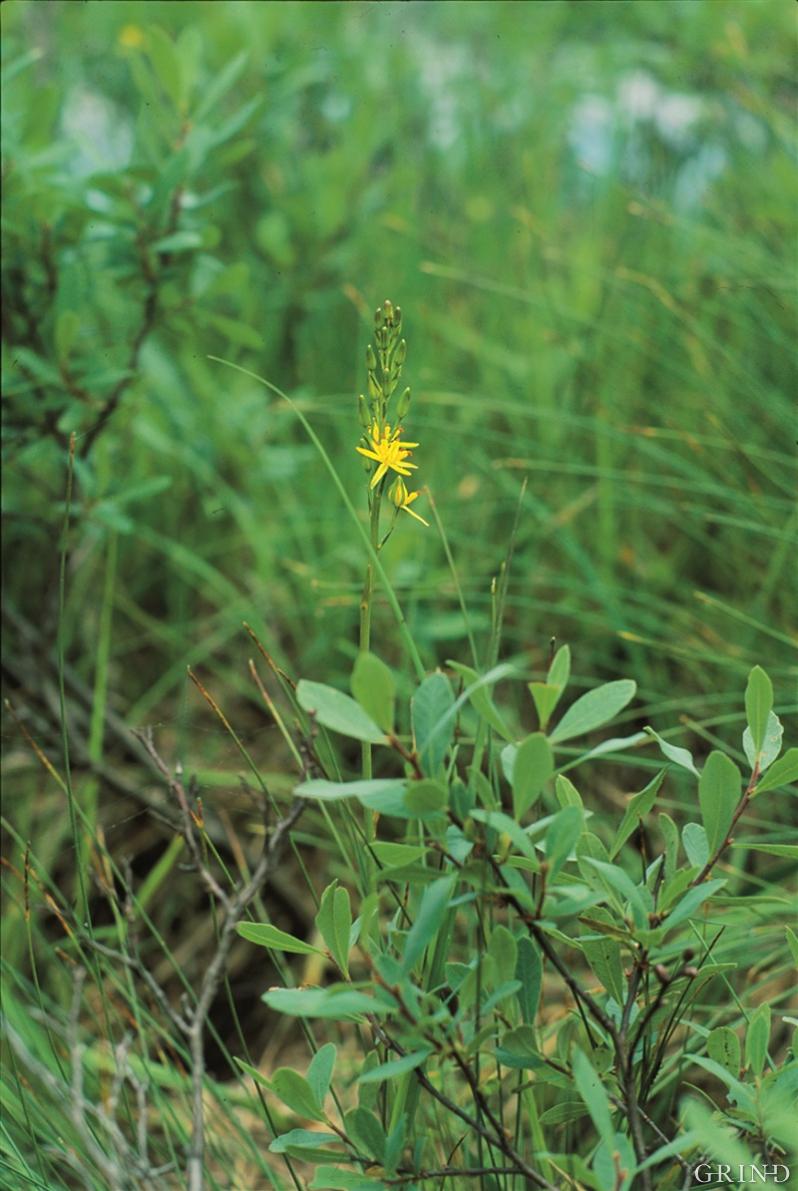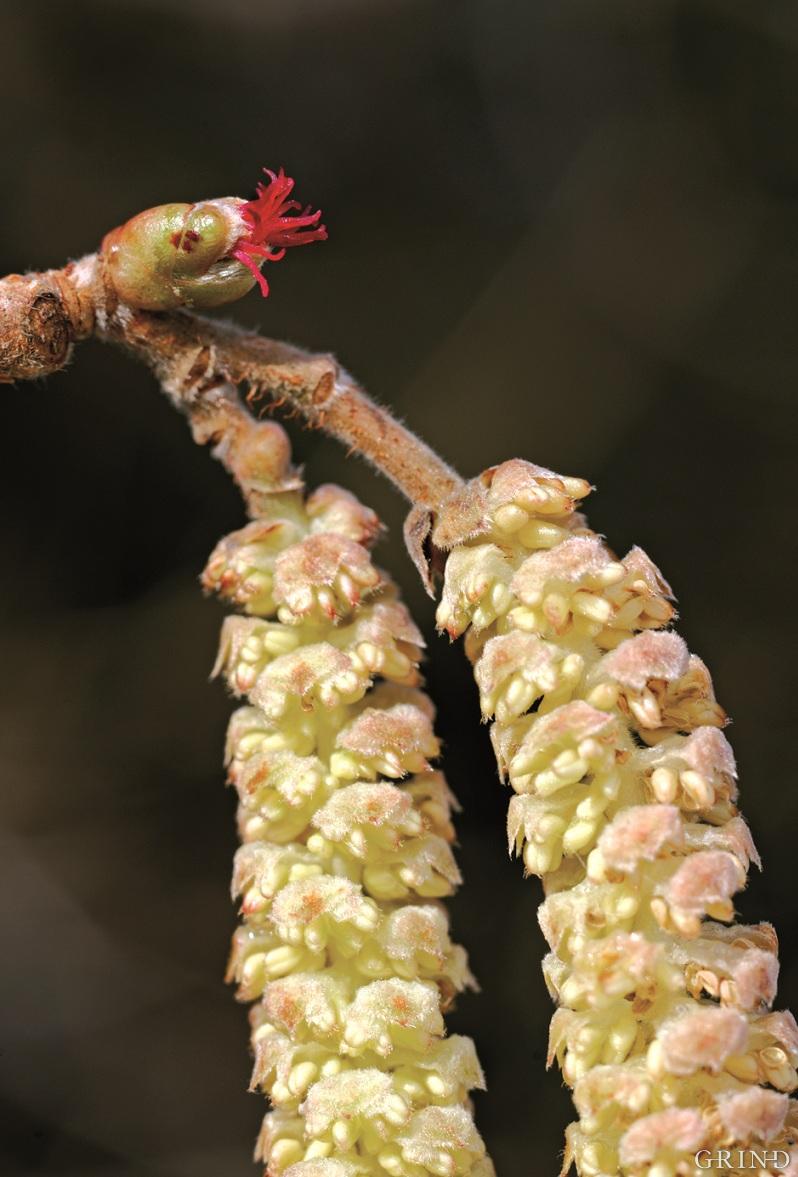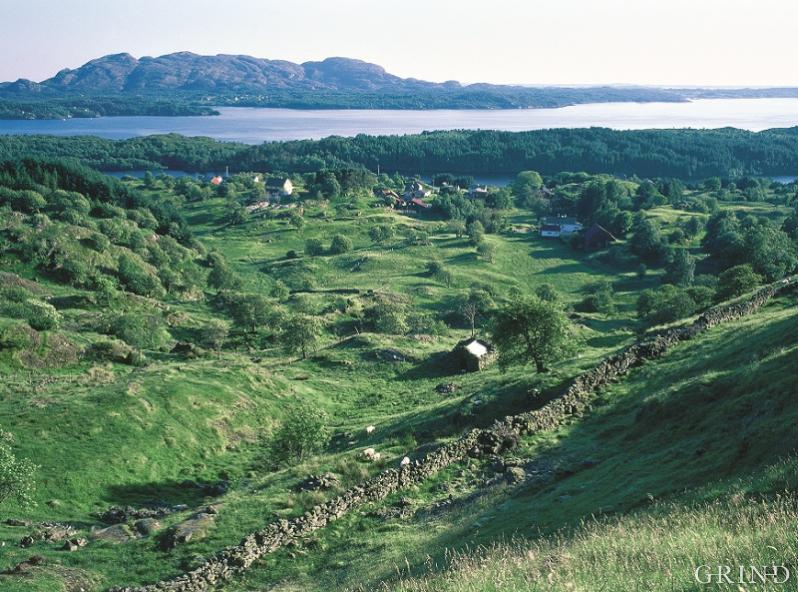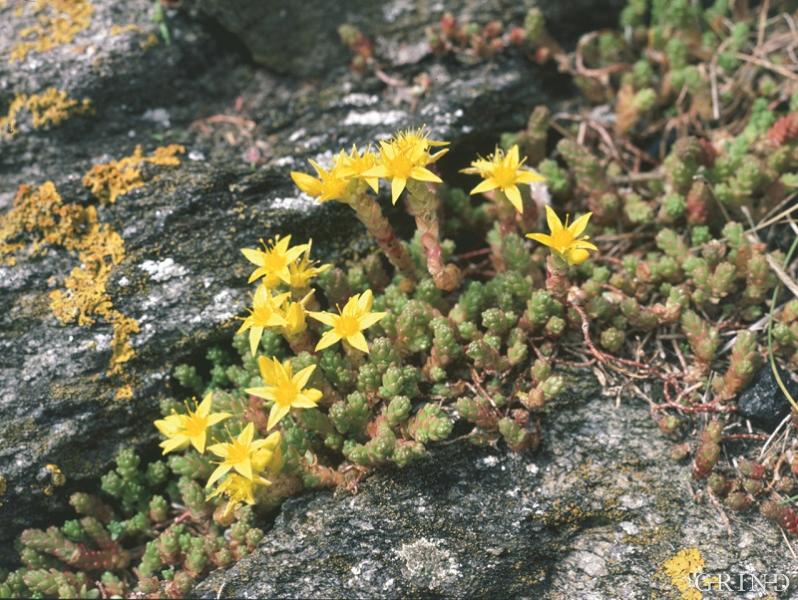Published: 19.05.2009 | Author: Mons Kvamme
A deciduous forest slop with Bear’s garlic. (Jan Rabben)
Have you ever experienced a quiet Sunday morning in Ullensvang, with the fruit trees in blossom and the snow white mountains mirrored in the shining fjord, or a romantic summer night at リster amongst the Michaelmas daisies, the harebells and the white campion - or a lazy August day on the naked rocks out on the sea, when all of the islands are clad in a lilac purple carpet of heather in bloom - you will never forget it. The outer frame - the coast, the fjord and the mountains - are an inheritance from the country's geological history. But what, more than anything else, gives the scene colour and excitement is the plant life.
Great variations over short distances
The most distinct feature of Hordaland’s plant life is its variety. From Fedje to Voss, or from Strandebarm to Maurset – the differences are so great that you would not believe these places were in the same county. If you drive from Stockholm to Bergen you will see that in the last few miles from the Hardanger Plateau to Bergen, the vegetation varies much more than on the whole of the trip otherwise. Great geological variations are an important reason for the changing natural conditions. Climate too plays a decisive role, and here the contrasts are great. On the coast you may go out in your shirtsleeves and pick new potatoes for Christmas whilst up at Røldal you can go ski-ing in sub-zero temperatures from November to June. On top of these regional variations lie local ones, and here the compass orientation on the direction of the slope plays an important role.
On south-facing slopes, the warming effect is not only better, the soil dries out better and has more air in it – to great benefit for the earthworm and the micro-organisms which make use of the exchange of minerals in the soil. Plant life is often richer than on north-facing slopes with later snow melting, less sun and more dampness. In such variable natural conditions as Hordaland experiences, these variations in local climates have a tremendous amount to say for how the landscape appears. From luxuriant deciduous slopes with oak and elm, just by crossing a promontory you can end up in a pine forest where the orientation changes from south facing to east facing.
Vegetation zones along the coast go the wrong way
The climate in large parts of western Norway is related to distance from the sea. The vegetation zones lie mainly parallel to the coast: from north to south, and not from east to west as is the case in most other places. There is a much greater variation in the vegetation between Sotra and Os than there is between Sotra and Frøya (300 kilometres to the north) on the coast of Trøndelag!
Out to sea in the west lie the treeless, wind-blown heather heaths. They cover most of the islands out to sea and part of the coastal zone in Nordhordland. Here we find some of the most exotic plants in the county - not with regard to needs for nutrients or high summer temperatures, but with regard to winter temperatures. They are so sensitive to frost that they rightly belong to more southerly latitudes.
A beautiful example is purple heather which already in early July gives the south-facing slopes furthest out to see a deep red colour. Other plants are the rare sea spleenwort and marsh pennywort which is reminiscent of a little parasol and grows on humid grassy slopes right out on the sea.
If you go inland over the heather heaths you will see that they are becoming overgrown today. Birch and mountain ash trees are taking root everywhere as well as a lot of pine trees. The further you go in the clearer it becomes, until at last you are standing in dense pine forest. Now you have entered the coastal pine forests. They lie like a belt inland from the heather heaths on the inner parts of the coastal zone and on much of the coastal hills.
The pine is an undemanding tree, but it cannot stand much competition. It is usually found in places where other trees will not thrive. But even in that zone inside the heather heaths the pine does not remain undisturbed. Where the soil is a little better oak groves and hazel scrub take over and if it is also a little damp then the black alder comes in with full force.
Fertile farms and forests with bulbs
In the outer fjord district the landscape changes character. Slopes with deciduous forest with elm and ash increasingly take over from pine, and together with oak, black alder and hazel they give the landscape a fertile feel to it. The farms too are usually bigger and better than further out on the coast. If you drive eastwards from Våge on Tysnes across the Luksund Bridge to Ølve, you will see this quite clearly. We have come into what we can call the “luxuriant fjord landscape”. It is here too that we find the finest area for special plant species such as holly and ivy.
On the south facing slopes up from the fjord summer temperatures can be fine. At the same time on a winter’s day the fjord can function as a “heat reservoir” so that winter temperatures are not so bad either. This means that a number of coast plants can manage here. If you stop the car and get out you can easily find a bunch. The first plants you will see will probably be foxgloves. It is a typical example of the coast plants that stop in the middle of the fjords, about Kvanndal. You find it most easily in road cuttings, on landslide areas or other areas with open land. Where the vegetation has been too dense it has been out-competed. But seeds are to be found in great numbers, and as soon as the plant cover is torn up, the foxgloves are back!
If you stand at the ferry quay at Hattvik and smell the scent of the bulbs, you must not think it comes from the nearby takeaway shop. It is only the smell of the broad-leaved garlic (ramsons) that you have noticed. They are common on these steep deciduous forest slopes. If you went up on to a slope like that with a botanist you would see many fine plants. But don’t take the bus home! Your clothes will reek of garlic. Everyone who has grown up in the outer regions of Western Norway has dug for groundnuts. Those who come from the inner reaches - or from the east - do not know what these are. The groundnut is a little white umbellifer with a thick nutritious root which, at its best, is reminiscent of tasteless hazelnuts, at least before Jonsok (Midsummer’s Eve). But it is fine for eating. Later on it becomes bitter and cannot be eaten. In Normandy this plant has a name which comes from Old Norse. In the rest of France it is called something completely different. Some researchers have therefore pointed out that the Vikings who settled here in Normandy must have originally come from western Norway since groundnuts do not grow anywhere else in Scandinavia.
Pizza spices on the road verges
The inner areas of the county are distinct from the rest of the county in several ways. The winters are colder, partly because the fjord no longer functions as a reservoir of warm water. But as long as it does not freeze, it is still not as cold as in the east. On the other hand the summers are warmer, and now have entered the areas with high precipitation – in some areas it can sometimes be relatively dry.
We count Kvanndal and the areas around Sørfjord as being within the inner fjords. Here it is the rich fruit-producing settlements which dominate. But nor should we forget the inland villages of Voss and Røldal.
On the steep fjord sides we find much deciduous forest. Here the lime is an important tree together with elms and hazel. For the most part black alder has disappeared and instead the hoary alder makes much of itself on bare areas, screes and river courses. On drier hills and on poor soils there stands the pine.
The warmer summers mean that some plants from eastern Norway have ventured over the hills and scratched out a place in the fjords. A good (and nutritious) example of this is wild marjoram or oregano. It is easy to spot on the dry rocky areas along the road when its opens up its reddish purple petals in summer. The whole plant smells lovely. If you dry it and crush it, you get an excellent spice. In the shops you buy it as oregano or pizza spice. Another such plant from eastern Norway which often grows on the road verges is great mullein which looks like a yellow spire, and the red flowered viscid campion with its sticky flower pedicles.
A brief tour in the mountains
If you go up into the mountains you will see that the vegetation changes when you get above the lowland zone, (300 metres above sea level). Up here it is the pine which is dominant, together with the hoary alder. This belt of forest goes up to 600 to 700 meters above sea level which has been reckoned to be the upper limit for farm settlements in the county. True enough there have been farms higher up at Maurset for example.
Up on the tops we come upon mountain birch. This is a phenomenon we only encounter in Scandinavia. In most other places in the world it is coniferous forest which forms the tree line both in the mountains and in the north. Remember that next time you struggle up through a birch forest! The best developed is the birch forest in inland areas. Here the tree line can go up to 1,100 metres above sea level. The further west you go the lower is the tree line. At Kattnakken (Stord) the climatic tree line is under 500 metres above sea level. Here there is not much sign of the mountain birch forest.
In the mountain forest you can also meet a Norwegian easterner, that is the poisonous Northern Wolfbane. It stretches as far west as the eastern boundary for foxgloves, but it is rarely that they meet; they grow at different altitudes. Another handsome flower up here in the mountains is Alpine lettuce, and if you are lucky you can also find the mighty mountain angelica (fjellkvann) with its greenish-white shields. It is not often to be seen today, but many names with “kvann” in them in Hordaland County show that it was more widespread previously and highly valued.
Above the climatic tree line, it is the base rock and the snow cover which determines the vegetation: mostly it is bog, heather and grassy heaths. Where there is a lot of chalk in the rock you can find colourful flower meadows. White rockroses, blue snow Gentian, red moss campion and yellow saxifrage are an encouraging sight, however tired you may be.
Hazel bushes tell a tale
The vegetation picture today is far from being constant. It is always changing, and has been doing so since the last Ice Age. This development is important to be aware of, and not least the relationship between mankind and plant life. The hazel tree demonstrates this in an excellent way. It rightly belongs to the fertile, sunny deciduous forest slopes in Varaldsøy, Strandbarm or Hatlestrand - and here you do not have to be a names researcher to understand where the name comes from. Nonetheless you will find this tree on almost every farm in the county, with the exception of the highest mountain farms. Along the roads and the fences, on the cut meadows and the small gardens for the calves, where other trees have been removed, the hazel still stands. Even far out on the heathlands the hazel has been allowed to stand on steep slopes and sheltered from the wind. When we realise how important this tree has been for traditional farm households, it is easy to understand this pattern. In addition came nut production which previously was of greater economic value than today. In the Middle Ages, hazelnuts were an approved way of settling up a debt.
But the very first hunter folk who settled on the coast of Hordaland 10,000 years ago ate hazel nuts. In any event the archaeologists found nutshells when they were excavating their settlements in Øygården and on Sotra. And research on the vegetation history of these settlements has shown that the hazel established itself here earlier than in other areas. That this tree species came to the country as soon as the ice had melted is a special feature of our inter-glacial period. In previous inter-glacial periods it was one of the last species which established itself, but then no people lived here either.
Another type of nature – with pine trees on the hardanger plateau
The first folk in Hordaland lived in a natural environment which was very different from the one we know today. It was moors of dwarf birch and crowberry, together with juniper and willow scrub which made up the landscape 10,000 years ago. The only tree of any significance was the birch tree. In technical terms, this vegetation was known as park tundra, and today we find something similar, for example, along the coasts of Greenland. This does not mean to say that the climatic conditions were so much worse than today. On the other hand the soil conditions were quite different. When the ice withdrew it left behind it a pure mineral soil. We can see this today at the Buar Glacier in Odda or at the Blue Glacier near Finse. The lack of organic material - humus - means that many plants simply cannot manage on such a soil. In addition both plants and animals had gone under cover during the Ice Age far south in Europe, and many of them needed some time to come back up here to the north.
As the years went by the park tundra was converted to birch forest, at the same time as new plants such as mountain ash, bird cherry and aspen began to appear. But the biggest changes first occurred about 8,500 years ago when the pine tree spread over the whole county from the furthest skerry to far up on the mountains. The climate had then been warmer, and the summer temperature had probably been a couple of degrees warmer than today. This means that the forest went further up the mountains. For example pine covered most of the Hardanger plateau, probably up to 1,250 metres above sea level. Most of this early pine forest later lost in competition with other tree species or with felling by Man, and we do not know with certainty of places where there has always been pine forest standing up until today. But it is possible that the mountain forests around Voss, for example in Bordalen, or in Sørfjorden are such ancient pine forest areas.
Hordaland was a deciduous forest county
About 8,000 years ago there were several events which led to changes in the vegetation. Plants and microorganisms had now provided the soil with so much organic material that it had been converted to good topsoil. At the same time the earth still contained the great wealth of nutrients from the mineral soils. The soil conditions have probably never been better here in the county, either before or after!
Those that first made an impact were the two species of alder, black alder and hoary alder. The black alder came along the coast from the south and the hoary alder come from the east through Finland and Sweden. But in fact they were not alone. About the same time the real deciduous forest began to arrive, first elm and oak and a little later, lime and ash. These species have a great advantage - they are often many hundreds of years old, while alders rarely last more than 50 years.
The primaveal forest is cultivated
About 5,000 years ago there were several events which led to changes in the vegetation. Even before acid rain became a problem for western Norway, after some thousands of years the rain had its effect upon the nutrient content of the soil. At the same time the summer temperature was not as high as it was before. This affected the higher areas along the tree line, and those plants with the greatest need for warmth and nutrients had difficulties in managing. By this time people had only just begun with animal husbandry and arable farming as part of their subsistence. As time passed this would have a lot to say for the vegetation of Hordaland. Pastures for the animals had to be cleared and the forests became more open and lighter. This meant that a whole new group of plants got a new chance. These were the plant species which needed light, both those we call weeds and many of the flower meadow species.
With arable farming, the culture plants came to the country. At the beginning these were primitive kinds of barley and wheat. And with the seed corn came species of weeds other than those that followed animal husbandry, and many of them with beautiful, colourful flowers, for example the corn poppy. A primitive cornfield could most easily bring to mind a flower garden, but in our modern and mechanised arable farming there is no room for this sort of thing. Early arable farming was often described as “slash and burn”. People burned the forest and cultivated in the ash until the soil was exhausted. Then they moved on. We have no proof of this from Hordaland. Here there was no area big enough for arable farming to allow such an extensive form of cultivation. Of course people had to move their fields when the soil became exhausted, but they had to keep within a limited area. In this way it was arable farming, above everything else, which got the people of Hordaland to change their means of subsistence, from being wandering hunters and trappers to settled farms with hunting and trapping as a subsidiary means of making a living.
The struggle for winter forage – The cultural landscape assumes form
The thing that affected the landscape outside the areas where people lived and had their fields was the struggle to provide winter forage. In the beginnings this must have been leaves. We know that leaf forage was part of the very first elements of animal husbandry, and we know that in the Stone and Bronze Ages they did not have any effective tools for harvesting grass with. On the other hand people could harvest the leaves from the trees without difficulty with the tools they had. The sickle, and perhaps the sheath knife, is perhaps the oldest tool made here in this country. Sickles from the Viking times are identical with modern ones. If we go back to the recent Stone Age we find similar tools made of flint. This shows how important the harvesting of leaves was and that folk early on found the most suitable techniques for this work.
In the fjord regions people were dependent on having winter forage for the livestock. And here it must have been a great innovation when they got the scythe in the Iron Age which put them in a position to harvest the grass in an effective manner. It was then that development towards the landscape that we know in our times began seriously. Larger and larger areas were cleared of forest and the hayfields spread more and more.
An important difference from our time is that much more of the cultivable land, which today is regarded as the home fields, was used for cultivation. In the Iron Age it was mostly barley, and then oats which was grown. The hayfields were largely in the uncultivated areas outside, and as the numbers of livestock grew, hayfields were cleared in the most improbable places. Of course we know this best from the 18th and 19th centuries, but we also know that as early as the Viking times the landscape was cultivated just as intensively as in later times.
After World War II mechanisation and rationalisation of agriculture has changed the traditional cultural landscape. The heathlands, the hayfields and the mountain pastures are in the process of becoming overgrown, and where it is possible, the rough grazing is being planted with fir. The landscape of the scythe, the horse and the sickle is giving way to the tractor, artificial fertiliser and fir forests.
- Fægri, K. (1958-1960, 1970) Norges planter: blomster og trær i naturen: med et utvalg fra våre nabolands flora. Oslo, Cappelen.
- Fægri, K. (1976) Floraen i Hordaland. I: Hartvedt, G. H. red. Hordaland og Bergen. Bygd og by i Norge. Oslo, Gyldendal, s. 165-180.
- Høeg, O. A. (1974) Planter og tradisjon: floraen i levende tale og tradisjon i Norge 1925-1973. Oslo, Universitetsforlaget.
- Kaland, P. E. (1979) Landskapsutvikling og bosetningshistorie i Nordhordlands lyngheiområde. I: Fladby, R. & Sandnes, J. red. På leiting etter den eldste garden. Oslo, Universitetsforlaget, s. 41-70.

